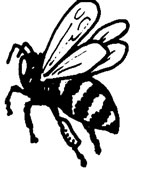|
This GEMS unit guides children through the fascinating world
of a honeybee community, their food gathering, life cycle, defenses,
and interdependence with flowers. We thought there would be tons
of literature on bees as the focus, but found most of the connections
to involve the ecology of the honeybee or how a bee’s life
is intertwined with other living things. In the Tall, Tall Grass
and The Rose in My Garden use rhyming verse to illustrate the
interconnectedness of meadow life with bees as important players.
Where Butterflies Grow describes the butterfly life cycle; a nice
comparison to bee metamorphosis. And in a classic book, honey
is central to a story about a familiar bear and his encounter
with bees.
The Flower Alphabet Book
A House is a House for Me
In the Tall, Tall Grass
Michael Bird-Boy
Pretend You’re A Cat
The Rose in My Garden
When I’m Sleepy
Where Butterflies Grow
Winnie-The-Pooh
The Flower Alphabet Book
by Jerry Pallotta; illustrated by Leslie Evans
Charlesbridge Press, Watertown, Massachusetts. 1988
Grades: Preschool–2
Beautiful alphabet picture book showing many varieties of flowers
and plants in accurate detail. Would make a good early primary
accompaniment to the meadows ideas in Hide a Butterfly and the
activities relating to nectar, pollen, and flowers in Buzzing
a Hive.
Return to title list.
A House is a House for Me
by Mary Ann Hoberman;
illustrated by Betty Fraser
Viking Penguin, New York. 1978
Grades: K–3
Lists in rhyme the dwellings of various animals, peoples, and
things such as a shell for a lobster or a glove for a hand. Nice
extension to “Lesson 3: Building A Bee Hive.”
Return to title list.
In the Tall, Tall Grass
by Denise Fleming
Henry Holt and Co., New York. 1991
Grades: Preschool–3
Rhyming text and vibrant collage illustrations look at the
world of creatures you might see in the long, tall grass. Their
behaviors are captured in catchy rhymes as caterpillars lunch,
hummingbirds sip and dip, bees strum, ants lug, and moles ritch,
ratch and scratch.
Return to title list.
Michael Bird-Boy
by Tomie dePaola
Simon & Schuster, New York. 1975
Grades: K–3
A young boy who loves the countryside determines to find the
source of the black cloud that hovers above it. When he discovers
the source of this pollution, a factory making “genuine”
artificial honey syrup, he helps the “boss-lady” set
up beehives so she can make natural honey without creating pollution.
Return to title list.
Pretend You’re A Cat
by Jean Marzollo; illustrated by Jerry Pinkney
Dial Books, New York. 1990
Grades: Preschool–1
Wonderful illustrations and friendly verses ask children to pretend
they are different animals and to act out the animal’s behavior.
“Can you buzz? Are you covered with fuzz?” Great springboard
to a discussion of similarity and differences among animal behaviors.
Animals include a cat, pig, snake, bear, horse, seal, and bee.
Return to title list.
The Rose in My Garden
by Arnold Lobel; illustrated by Anita Lobel
Greenwillow Books, New York. 1984
Grades: Preschool–2
Each page adds a new rhyming line to a poem as a beautiful
garden of flowers, insects, and animals grows. A surprise interaction
among the garden residents takes place at the end of the book.
Young readers will enjoy the repeated patterns in the story.
Return to title list.
When I’m Sleepy
by Jane R. Howard; illustrated by Lynne Cherry
Dutton, New York. 1985
Grades: Preschool–2
A young girl speculates about sleeping in places other than
her bed and is shown sleeping with twelve different animals in
a nest, a swamp, standing up, hanging upside down, etc. The witty,
glowing illustrations and active verbs capture a wide range of
habitats and possibilities.
Return to title list.
Where Butterflies Grow
by Joanne Ryder; illustrated by Lynne Cherry
Lodestar Books, New York. 1989
Grades: K–5
Here’s an imaginative description of what it might feel
like to grow from a tiny egg into a black swallowtail butterfly.
Structure, metamorphosis, locomotion, camouflage, and feeding
behaviors are all described from the point of view of the butterfly.
There’s also a page of gardening tips on how to attract butterflies.
Outstanding illustrations include detailed drawings of metamorphosis.
Return to title list.
Winnie-The-Pooh
by A.A. Milne; illustrations by Ernest H. Shepard
E.P. Dutton, New York. 1926
Dell Publishing, New York. 1954
Grades: K–5
This well-loved classic contains chapter after delightful
chapter of the adventures of Christopher Robin, Pooh, and their
animal friends. Relevant chapters include one in which bees are
encountered; several in which logic is applied to solve a problem;
and an adventure in navigation.
Return to title list.
|


|


